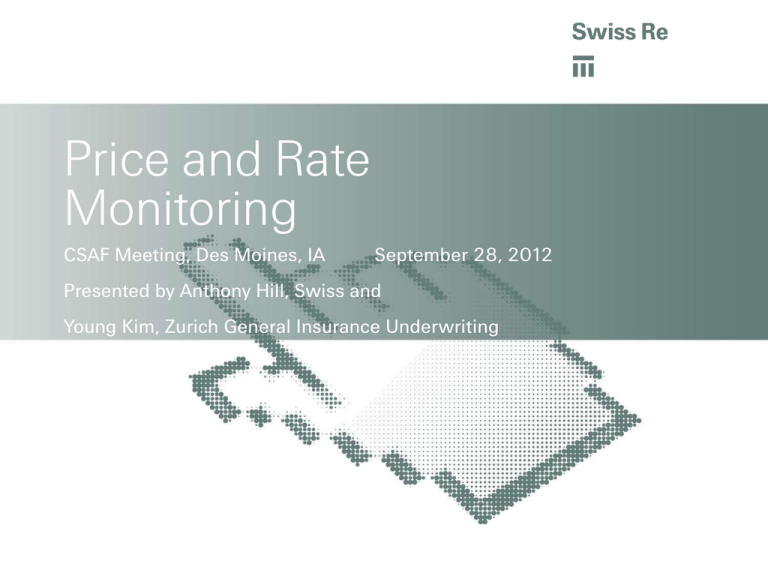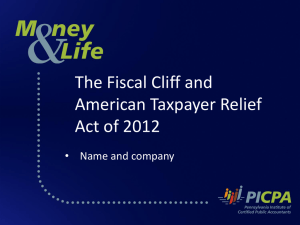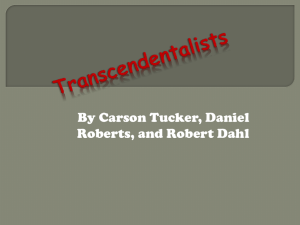
Price and Rate
Monitoring
CSAF Meeting, Des Moines, IA
September 28, 2012
Presented by Anthony Hill, Swiss and
Young Kim, Zurich General Insurance Underwriting
Table of Contents / Agenda
Price/Rate Monitoring Introduction
Various Approaches to Price/Rate Monitoring
Price/Rate (Adequacy) Change Example
Comparison of Results
Zurich's Approach to Rate Monitoring
Backward/Forward Walks
Decisions & Challenges in Price/Rate
Monitoring
Conclusions
2
Price/Rate Monitoring
Introduction
3
Price/Rate Monitoring – What is it?
Simple definition: a measurement of the change in rate levels from one
period to another – what the customer typically feels.
A more complex definition: a measurement of the change in effective rate
levels from one period to another (reflecting mix shift) – how our rate
adequacy changes over time.
Absolute rate level or rate adequacy is not critical. It's the change in rates
or rate levels that we're concerned with.
4
Price/Rate Monitoring – Purpose & Uses
Track changes in rate levels over time
Allows for the projection of historical loss ratios to a future period for
profitability and forecasting purposes
Allows backward walk of current costing loss ratios to see if they are
consistent with historical results (Pricing-Reserving Linkage)
Facilitate analysis of strengthening and erosion in loss picks
Facilitates planning, providing granularity into the source of historical
premium changes (e.g. exposure, growth, rate)
Critical part of portfolio steering; particularly powerful when combined
with hit rates, retention rates, and industry price monitors
Useful tool in driving underwriter behavior and providing timely feedback
5
Various Approaches to
Price/Rate Monitoring
6
Price/Rate Monitoring Approaches
Three basic approaches to price/rate monitoring
Method 1: Change in standard rates or benchmarks plus the impact of
changes in certain credits and debits
Method 2: Change in price per exposure – portfolio and matched renewals
Method 3: Change in price relative to benchmark
Method 1: Changes in Standard/Filed Rates
with Selected Credits/Debits
Description:
Price change is calculated as a combination of changes in standard/filed rates plus changes in certain credits and debits. Credits/debits
that change due to movements in the underlying exposure to loss (e.g. credits for adding sprinklers) are usually excluded from the
calculation.
Applicable Segments:
•US Admitted and other segments where rates are filed and/or
highly structured
•Works best on stable portfolios with high renewal retention ratios
Advantages:
•Widely recognized and accepted by external regulators and rating
agencies
•Filed rate change impacts are readily available for admitted
business as part of rate filings
•All but judgemental credits/debits are known at time rates are
committed to (filed).
Policy/Portfolio Metrics:
•Usually applied at portfolio level
•For portfolio, impact of changes to each rating variable are
calculated independently.
•More complex policy-level calculations that consider interactions of
rating variables are possible with appropriate systems. The most
robust method allows for re-rating past policies with current rating
plan.
Disadvantages:
•Requires a fixed pricing structure
•Normally a renewal pricing metric; (Change in) price adequacy is
not directly calculated.
•Does not typically reflect the impact of new/lost business.
•For portfolio calculations, historical rate changes usually reflect
exposure at time rates were filed. They may not be accurate for the
current portfolio.
•Determining how to handle changes in debits/credits can be
problematic. This is particularly true for experience rating, which is
intended to be predictive of loss potential. The problem comes when
adding a year of experience on a renewal (and typically dropping an
old year) produces significantly different credits/debits without a
change in underlying exposure.
Method 2a: Changes in Price per Exposure Portfolio Calculation
Description:
Price change is calculated as the change in premium per exposure for the full portfolio. Exposure can be defined in a variety of ways, but
must be available for all policies.
Applicable Segments:
•Works best on stable portfolios with relatively homogeneous
exposures.
•Stratification can be used to expand applicability to large portfolios
having heterogeneous exposures.
Advantages:
•Easily understood and easily calculated.
•Includes impact of new and lost business.
•As a simple metric, it is readily available and can be a good leading
indicator of price changes that are calculated more accurately.
Policy/Portfolio Metrics:
•The metric is calculated at the portfolio level.
•The calculation can be driven down to the policy level, but is so
crude that it will only be credible for matched renewals.
Disadvantages:
•Requires a single exposure metric for all policies. Often this can
mean that the exposure metric is highly simplified (e.g. policy count
or limits sold).
•There may be significantly different values of the same metric if
multiple exposure bases are available and used – with little
guidance on which is most accurate.
•Extremely crude price metric. It can be misleading under a wide
variety of scenarios. Examples include:
-Writing or cancelling a single large policy
-A significant change in layers written
-Mix shifts between classes
Method 2b: Changes in Price per Exposure Matched Renewals
Description:
Price change is calculated as the change in premium per exposure for each renewing policy. Exposure can be defined in a variety of ways,
but is most often the exposure base used to price or cost the policy (e.g. sales or turnover).
Applicable Segments:
•Works best on stable portfolios with relatively homogeneous
exposures.
•Stratification can be used to expand applicability to large portfolios
having heterogeneous exposures.
Advantages:
•Easily understood and easily calculated.
•Most closely matches price changes felt by customers.
•Impact can be attributed to individual policies.
Policy/Portfolio Metrics:
•Policies having significant changes in exposure, limits, or
deductibles/SIR's are typically excluded.
•Portfolio metrics can be calculated as a weighted average of
individual policy changes, where price changes are normally
weighted by expiring premium.
Disadvantages:
•Purely a renewal pricing metric; (Change in) price adequacy is not
directly calculated.
•Does not directly reflect the impact of new/lost business. However
there are some techniques for incorporating the impact of new/lost
business.
•If portfolio is changing significantly, the metric may be based on a
relatively small sample of policies (renewals with only minimal
exposure/limit/deductible changes). This sample may be highly
skewed, particularly if portfolio shifts are driven by re-underwriting
efforts.
Method 3: Changes in Price relative to
Benchmark
Description:
Actual premium is divided by benchmark premium (or loss cost) to produce a price adequacy index. Effective Price change (measuring
change in price adequacy) is calculated as the change in this price adequacy index over time.
Applicable Segments:
•Can apply across a broad variety of portfolios as long as a
benchmark price or loss cost exists (and has existed historically).
Advantages:
•Measures (Re)insurer's current view of historical changes in price
adequacy.
•The most robust and accurate method available.
•Can be used with either loss costs (e.g. raw benchmarks) or fully
loaded indicated costs.
•Applied regardless of new business or renewal business.
•Can be calculated at time of quoting/binding.
Policy/Portfolio Metrics:
•Calculated for each transaction and summed to produce portfolio
metrics.
Disadvantages:
•Requires sophisticated costing systems in order to re-price
historical policies with current benchmarks.
•Does not directly measure price change felt by customers.
•Assumes all benchmark prices or loss costs are equally adequate,
which is often not the case.
•When benchmarks change, the historical price adequacy index
should be restated, which can be extremely difficult if rating
variables have changed over time.
•The restatement of the historical price adequacy can produce
significant revisions over the full history of the segment –
something that may be challenging to explain and manage.
•If experience rating is a significant part of costing, it can be difficult
to properly incorporate its impact. Often it is excluded.
Price Monitoring – A.M. Best View
– A.M. Best requires separate price monitoring on New and Renewal business in
its Supplemental Rating Questionnaire (SRQ).
– Four year history
– For each annual statement line
– Uses Method 1: Change in filed rates plus credits/debits
– Adds adjustments for New Busines
Renewal Business
•Direct Premium Written (DPW) on Renewed Policies
•Number of Policies Renewed
•Average Change in DPW due to Filed Rate Changes
•Average Rate Modification due to Schedule Credits/Debits
•Average Rate Modification due to Other Pricing Adjustments
•Total Average Change in Pricing
•Price Level Indexed to Initial Year
•Material Changes in T&C and whether impact is included in pricing
changes
New Business
•Direct Premium Written (DPW) on New Policies
•Number of New Policies
•Average Rate Modification due to Schedule Credits/Debits
•Average Rate Modification due to Other Pricing Adjustments
•New Policies Price Level Relative to Renewal Price Level
12
Price/Rate (Adequacy)
Change Example
13
Basic Information
PRICE MONITORING EXAMPLE: 8 POLICIES
As-Priced
Benchmark
Experience
Cr/Db
Yes
$
2,538
$
(254) $
216
$
2,500
$
Yes
$
2,931
$
(293) $
62
$
2,700
$
2,931
50,000,000
No
$
34,650
$
5,198
153
$
40,000
$
36,383
$
52,000,000
Yes
$
37,838
$
(3,784) $
10,946
$
45,000
$
37,838
$
400,000,000
Yes
$
168,437 $
(8,422) $
(10,015) $
150,000 $
194,545
100% $ 8,000,000 $ 2,000,000
$
380,000,000
Yes
$
184,818 $
(9,241) $
(55,577) $
120,000 $
184,818
100% $ 8,000,000 $ 2,000,000
$
300,000,000
Yes
$
134,750 $
(6,737) $
(8,012) $
120,000 $
155,636
Excess
100% $ 5,000,000 $ 5,000,000
$
320,000,000
No
$
45,276
$
11,319
$
(6,595) $
50,000
$
45,276
Excess
100% $ 3,000,000 $ 2,000,000
$
300,000,000
Yes
$
98,000
$
(4,900) $
(23,100) $
70,000
$
113,190
Expiring
Excess
100% $ 5,000,000 $ 5,000,000
$
300,000,000
Yes
$
36,750
$
(1,838) $
15,088
$
50,000
$
42,446
New/Renew
Excess
100% $ 5,000,000 $ 5,000,000
$
320,000,000
Yes
$
45,276
$
(2,264) $
6,988
$
50,000
$
45,276
Status
Policy 1
Expiring
Primary
100% $ 1,000,000 $
-
$
400,000
New/Renew
Primary
100% $ 1,000,000 $
-
$
440,000
Expiring
Primary
100% $ 5,000,000 $
-
$
New/Renew
Primary
100% $ 5,000,000 $
-
Expiring
Excess
100% $ 8,000,000 $ 2,000,000
New/Renew
Excess
Expiring
Excess
New/Renew
Expiring
Policy 2
Policy 3
Policy 4
Policy 5
Type
Share
Limit
Deductible
Share-Adjusted
Exposure
Policy
Loss
Free
Schedule
Cr/Db
$
Charged
Premium
Current
Benchmark
2,665
New/Renew
Policy 6
Policy 7
Policy 8
Total
Expiring
$
New/Renew
Primary
100% $ 5,000,000 $
-
$
52,000,000
Expiring
Primary
100% $ 5,000,000 $
-
$
New/Renew
Primary
50% $ 5,000,000 $
-
$
Expiring
New/Renew
-
$
Yes
$
77,175
$
(7,718) $
52,000,000
No
$
73,500
$
11,025
26,000,000
Yes
$
38,588
$
$
$
548,625 $
431,901 $
(5,928) $
(15,839) $
$ 1,402,400,000
$ 1,150,440,000
-
20,543
$
90,000
$
77,175
$
5,475
$
90,000
$
77,175
(3,859) $
10,271
$
45,000
$
38,588
522,500 $
402,700 $
622,039
431,901
(20,196) $
(13,362) $
Key Assumptions:
Benchmark rates have increased 5% at Renewal; Rates on Excess/Deductible policies have increased an additional 10%.
The Experience Rating Plan is unchanged:
Primary: Loss-free receives 10% Credit; all others receive 15% Debit.
Excess: Loss-free receives 5% Credit; all others receive 25% Debit.
The Schedule rating plan is unchanged and based on underwriter discression.
Exposures are inflating at 2% annually. Claim Frequency is trending at -1% annually. Claim Severity is trending at 3% for primary and 5% for excess.
All premiums are net of acquisition costs.
14
Method 1: Changes in
Standard/Filed Rates
with Selected Credits/Debits
15
Method 1: Rate Change Breakdown
Expiring
Price/Rate
Change
New/Renew
Price/Rate
Change
Base Rate / Benchmark Changes (+5%)
5.0%
5.0%
Class Relativity Changes (NC)
0.0%
0.0%
Territory Relativity Changes (NC)
0.0%
0.0%
Increased Limit Factor Changes (+10% on Excess Policies)
8.0%
6.2%
Change in Experience Rating Plan (NC)
0.0%
0.0%
Change in Schedule Rating Plan (NC)
0.0%
0.0%
Total Rate Change based on Expiring
13.4%
11.5%
Category
16
Method 1: Change in Benchmark rates
with credits and debits
Current
Benchmark
Benchmark
Change
Policy 1
Expiring
Primary
100% $ 1,000,000
$
-
$
400,000
$
2,538
$
2,538
$
2,665
New/Renew
Primary
100% $ 1,000,000
$
-
$
440,000
$
2,931
$
2,792
$
2,931
Expiring
Primary
100% $ 5,000,000
$
-
$
50,000,000
$
34,650
$
34,650
$
36,383
New/Renew
Primary
100% $ 5,000,000
$
-
$
52,000,000
$
37,838
$
36,036
$
37,838
Expiring
Excess
100% $ 8,000,000
$ 2,000,000
$
400,000,000
$
168,437
$
168,437
$
194,545
New/Renew
Excess
100% $ 8,000,000
$ 2,000,000
$
380,000,000
$
184,818
$
160,015
$
184,818
Expiring
Excess
100% $ 8,000,000
$ 2,000,000
$
300,000,000
$
134,750
$
134,750
$
155,636
New/Renew
Excess
100% $ 5,000,000
$ 5,000,000
$
320,000,000
$
45,276
$
39,200
$
45,276
Expiring
Excess
100% $ 3,000,000
$ 2,000,000
$
300,000,000
$
98,000
$
98,000
$
113,190
15.5%
15.5%
Policy 4
Policy 5
Deductible
Prior
Benchmark
Type
Policy 3
Limit
As-Priced
Benchmark
Status
Policy 2
Share
Share-Adjusted
Exposure
Policy
New/Renew
Policy 6
Policy 7
Policy 8
Total
$
Excess
100% $ 5,000,000
$ 5,000,000
$
300,000,000
$
36,750
$
36,750
$
42,446
New/Renew
Excess
100% $ 5,000,000
$ 5,000,000
$
320,000,000
$
45,276
$
39,200
$
45,276
$
-
$
5.0%
15.5%
15.5%
-
Expiring
Expiring
5.0%
-
$
-
5.0%
New/Renew
Primary
100% $ 5,000,000
$
-
$
52,000,000
$
77,175
$
73,500
$
77,175
Expiring
Primary
100% $ 5,000,000
$
-
$
52,000,000
$
73,500
$
73,500
$
77,175
New/Renew
Primary
50% $ 5,000,000
$
-
$
26,000,000
$
38,588
$
36,750
$
38,588
Expiring
$ 1,402,400,000
$
548,625
$
548,625
$
622,039
13.4%
New/Renew
$ 1,150,440,000
$
431,901
$
387,493
$
431,901
11.5%
17
5.0%
Method 1: Rate Adequacy Adjustments
for Rates and Trend
PRICE MONITORING EXAMPLE: 8 POLICIES
Status
Type
Policy 1
Expiring
Primary
100% $ 1,000,000
$
-
$
New/Renew
Primary
100% $ 1,000,000
$
-
Expiring
Primary
100% $ 5,000,000
$
-
New/Renew
Primary
100% $ 5,000,000
$
-
Expiring
Excess
100% $ 8,000,000
$ 2,000,000
New/Renew
Excess
100% $ 8,000,000
Expiring
Excess
New/Renew
Excess
Expiring
Policy 2
Policy 3
Policy 4
Policy 5
Share
Limit
Share-Adjusted
Exposure
Policy
Deductible
As-Priced
Benchmark
400,000
$
$
440,000
$
50,000,000
$
52,000,000
$
400,000,000
$ 2,000,000
$
100% $ 8,000,000
$ 2,000,000
100% $ 5,000,000
$ 5,000,000
Excess
100% $ 3,000,000
Expiring
Excess
New/Renew
Excess
Current
Benchmark
2,538
$
2,665
$
2,931
$
2,931
$
34,650
$
36,383
$
37,838
$
37,838
$
168,437
$
194,545
380,000,000
$
184,818
$
184,818
$
300,000,000
$
134,750
$
155,636
$
320,000,000
$
45,276
$
45,276
$ 2,000,000
$
300,000,000
$
98,000
$
100% $ 5,000,000
$ 5,000,000
$
300,000,000
$
36,750
100% $ 5,000,000
$ 5,000,000
$
320,000,000
$
45,276
Benchmark
Change
Exposure
Trend
Frequency
Trend
Severity
Trend
5.0%
2.0%
-1.0%
3.0%
5.0%
2.0%
-1.0%
3.0%
15.5%
2.0%
-1.0%
5.0%
15.5%
2.0%
-1.0%
5.0%
113,190
15.5%
2.0%
-1.0%
5.0%
$
42,446
15.5%
2.0%
-1.0%
5.0%
$
45,276
5.0%
2.0%
-1.0%
3.0%
5.0%
2.0%
-1.0%
3.0%
New/Renew
Policy 6
Policy 7
Policy 8
Total
Expiring
$
-
$
-
New/Renew
Primary
100% $ 5,000,000
$
-
$
52,000,000
$
77,175
$
77,175
Expiring
Primary
100% $ 5,000,000
$
-
$
52,000,000
$
73,500
$
77,175
New/Renew
Primary
50% $ 5,000,000
$
-
$
26,000,000
$
38,588
$
38,588
Expiring
$ 1,402,400,000
$
548,625
$
622,039
13.4%
2.0%
-1.0%
3.8%
New/Renew
$ 1,150,440,000
$
431,901
$
431,901
11.5%
2.0%
-1.0%
4.1%
18
Method 1: Rate Adequacy Adjustments
for Experience & Schedule Rating*
Policy
Policy 1
Policy 2
Policy 3
Policy 4
Policy 5
Status
Type
Share
Limit
Share-Adjusted
Exposure
Deductible
Expiring
Primary
100% $ 1,000,000
$
-
$
New/Renew
Primary
100% $ 1,000,000
$
-
Expiring
Primary
100% $ 5,000,000
$
-
New/Renew
Primary
100% $ 5,000,000
$
-
Expiring
Excess
100% $ 8,000,000
New/Renew
Excess
100% $ 8,000,000
Expiring
Excess
New/Renew
Expiring
Loss
Free
As-Priced
Benchmark
400,000
Yes
$
$
440,000
Yes
$
50,000,000
No
$
52,000,000
$ 2,000,000
$
$ 2,000,000
$
100% $ 8,000,000
$ 2,000,000
Excess
100% $ 5,000,000
Excess
Expiring
New/Renew
Experience
Cr/Db
2,538
$
$
2,931
$
$
34,650
$
5,198
Yes
$
37,838
$
400,000,000
Yes
$
168,437
380,000,000
Yes
$
184,818
$
300,000,000
Yes
$
$ 5,000,000
$
320,000,000
No
100% $ 3,000,000
$ 2,000,000
$
300,000,000
Excess
100% $ 5,000,000
$ 5,000,000
$
Excess
100% $ 5,000,000
$ 5,000,000
$
Schedule
Cr/Db
(254)
$
(293)
Charged
Premium
216
$
2,500
$
62
$
2,700
$
153
$
40,000
(3,784)
$
10,946
$
45,000
$
(8,422)
$
(10,015)
$
150,000
$
(9,241)
$
(55,577)
$
120,000
134,750
$
(6,737)
$
(8,012)
$
120,000
$
45,276
$
11,319
$
(6,595)
$
50,000
Yes
$
98,000
$
(4,900)
$
(23,100)
$
70,000
300,000,000
Yes
$
36,750
$
(1,838)
$
15,088
$
50,000
320,000,000
Yes
$
45,276
$
(2,264)
$
6,988
$
50,000
New/Renew
Policy 6
Policy 7
Policy 8
Total
Expiring
$
-
New/Renew
Primary
100% $ 5,000,000
$
-
$
52,000,000
Yes
$
77,175
$
(7,718)
$
20,543
$
90,000
Expiring
Primary
100% $ 5,000,000
$
-
$
52,000,000
No
$
73,500
$
11,025
$
5,475
$
90,000
New/Renew
Primary
50% $ 5,000,000
$
-
$
26,000,000
Yes
$
38,588
$
(3,859)
$
10,271
$
45,000
Expiring
$ 1,402,400,000
$
548,625
$
(5,928)
$
(20,196)
$
522,500
New/Renew
$ 1,150,440,000
$
431,901
$
(15,839)
$
(13,362)
$
402,700
Expiring %
-1.1%
-3.7%
Renewing %
-3.7%
-3.2%
Change
-2.6%
0.5%
*Technically should include only to the extent it does not change expected losses. However this is difficult to determine, particularly on an individual risk
19
Method 1: Change in Rate Adequacy
Conversion to Price/Rate Adequacy Change
Category
Price/Rate
Adequacy
Change
Total Price Change
13.4%
Exposure Inflation (2.0%)
2.0%
Claims Frequency Trend (-1%)
1.0%
Claims Severity Trend (+3% Primary; +5% Excess)
-3.6%
Change in Cr/Db due to experience* (improved experience)
-2.6%
Change in Cr/Db due to schedule rating* (+0.5%)
0.5%
Change in Mix due to UW, T&C, Layers, other
-0.8%
Total Price/Rate Adequacy Change Excluding Mix Impacts
10.2%
Total Price/Rate Adequacy Change
9.3%
Comments
Based on Expiring
Based on Expiring (1/1.038-1)
To reconcile with Method 3
From Method 3
*Technically should include only to the extent it does not change expected losses. However this is difficult to determine, particularly on an individual
risk.
20
Method 2: Changes in
Price per Exposure Portfolio & Matched
Renewals
21
Method 2a: Portfolio Price per Exposure
METHOD 2: CHANGE IN PRICE PER EXPOSURE - MATCHED RENEWALS & PORTFOLIO
Premium
Divided by
Exposure
0.625%
0.614%
Policy
Policy 1
Status
Expiring
New/Renew
Type
Share
Limit
Deductible
Primary
100% $ 1,000,000 $
Primary
100% $ 1,000,000 $
-
Exposure*
$
400,000
$
440,000
Premium
$
2,500
$
2,700
Policy 2
Expiring
New/Renew
Primary
Primary
100% $ 5,000,000
100% $ 5,000,000
$
$
$
$
50,000,000
52,000,000
$
$
40,000
45,000
0.080%
0.087%
Policy 3
Expiring
New/Renew
Excess
Excess
100% $ 8,000,000
100% $ 8,000,000
$ 2,000,000
$ 2,000,000
$
$
400,000,000
380,000,000
$
$
150,000
120,000
0.038%
0.032%
Policy 4
Expiring
New/Renew
Excess
Excess
100% $ 8,000,000
100% $ 5,000,000
$ 2,000,000
$ 5,000,000
$
$
300,000,000
320,000,000
$
$
120,000
50,000
0.040%
0.016%
Policy 5
Expiring
New/Renew
Excess
100% $ 3,000,000
$ 2,000,000
$
300,000,000
$
70,000
0.023%
Policy 6
Expiring
New/Renew
Excess
Excess
100% $ 5,000,000
100% $ 5,000,000
$ 5,000,000
$ 5,000,000
$
$
300,000,000
320,000,000
$
$
50,000
50,000
0.017%
0.016%
Policy 7
Expiring
New/Renew
Primary
100% $ 5,000,000
$
-
$
52,000,000
$
90,000
0.173%
Policy 8
Expiring
New/Renew
Primary
Primary
100% $ 5,000,000
50% $ 5,000,000
$
$
-
$
$
52,000,000
26,000,000
$
$
90,000
45,000
0.173%
0.173%
TOTAL
Expiring
New/Renew
$
$
1,402,400,000
1,150,440,000
$
$
522,500
402,700
0.037%
0.035%
-
Portfolio Price/Exposure Change
-6.0%
22
.035/.037-1
Method 2b: Matched Renewal Price per
Exposure
Policy Status
Policy 1 Expiring
New/Renew
Type
Share
Limit
Primary 100% $ 1,000,000
Primary 100% $ 1,000,000
Deductible
$
$
-
$
$
Exposure*
400,000
440,000
$
$
Premium
2,500
2,700
Premium
Divided by
Exposure
0.625%
0.614%
Policy 2 Expiring
New/Renew
Primary
Primary
100% $ 5,000,000
100% $ 5,000,000
$
$
$
$
50,000,000
52,000,000
$
$
40,000
45,000
0.080%
0.087%
Yes
8.2%
Policy 3 Expiring
New/Renew
Excess
Excess
100% $ 8,000,000
100% $ 8,000,000
$ 2,000,000 $
$ 2,000,000 $
400,000,000
380,000,000
$
$
150,000
120,000
0.038%
0.032%
Yes
-15.8%
Policy 4 Expiring
New/Renew
Excess
Excess
100% $ 8,000,000
100% $ 5,000,000
$ 2,000,000 $
$ 5,000,000 $
300,000,000
320,000,000
$
$
120,000
50,000
0.040%
0.016%
No-Limits
Policy 5 Expiring
New/Renew
Excess
100% $ 3,000,000
$ 2,000,000 $
300,000,000
$
70,000
0.023%
Policy 6 Expiring
New/Renew
Excess
Excess
100% $ 5,000,000
100% $ 5,000,000
$ 5,000,000 $
$ 5,000,000 $
Policy 7 Expiring
New/Renew
Primary
100% $ 5,000,000
$
-
Policy 8 Expiring
New/Renew
Primary
Primary
100% $ 5,000,000
50% $ 5,000,000
$
$
-
TOTAL Expiring
New/Renew
-
Matched
Renewal?
Renewal
Rate
Change
Yes
-1.8%
Matched
Expiring
Premium
$
2,500
$
$
Matched Exp.
Premium X
(1+Rate Ch.)
0.017%
0.016%
Yes
$
$
52,000,000
$
90,000
0.173%
No-New
$
$
52,000,000
26,000,000
$
$
90,000
45,000
0.173%
0.173%
Yes
$
$
1,402,400,000
1,150,440,000
$
$
522,500
402,700
0.037%
0.035%
43,269
$
126,316
150,000
$
-
$
50,000
50,000
$
$
$
-
$
-
-
$
50,000
$
-6.3%
$
$
$
$
90,000
$
308,915
332,500
Matched Renewal Rate Change
$
-
$
-
-
53,333
-7.1%
Expiring Wgts
308,915/332,500-1
50,000
-
45,000
$
$
23
45,000
$
$
$
$
142,500
-
90,000
0.0%
2,700
$
$
$
$
41,600
46,875
-
Matched
Renewing
Premium
$ 120,000
$
No-Expired
$
$
2,455
40,000
$
300,000,000
320,000,000
$
Matched Ren.
Premium /
(1+Rate Ch.)
$
2,750
45,000
285,183
$ 262,700
-7.9%
N/R Wgts
262,700/285,183-1
Method 2b: Rate Adequacy Adjustments
for Trend
PRICE MONITORING EXAMPLE: 8 POLICIES
Status
Type
Policy 1
Expiring
Primary
100% $ 1,000,000
$
-
$
New/Renew
Primary
100% $ 1,000,000
$
-
Expiring
Primary
100% $ 5,000,000
$
-
New/Renew
Primary
100% $ 5,000,000
$
-
Expiring
Excess
100% $ 8,000,000
$ 2,000,000
New/Renew
Excess
100% $ 8,000,000
Expiring
Excess
New/Renew
Excess
Expiring
Policy 2
Policy 3
Policy 4
Policy 5
Share
Limit
Share-Adjusted
Exposure
Policy
Deductible
As-Priced
Benchmark
400,000
$
$
440,000
$
50,000,000
$
52,000,000
$
400,000,000
$ 2,000,000
$
100% $ 8,000,000
$ 2,000,000
100% $ 5,000,000
$ 5,000,000
Excess
100% $ 3,000,000
Expiring
Excess
New/Renew
Excess
Current
Benchmark
2,538
$
2,665
$
2,931
$
2,931
$
34,650
$
36,383
$
37,838
$
37,838
$
168,437
$
194,545
380,000,000
$
184,818
$
184,818
$
300,000,000
$
134,750
$
155,636
$
320,000,000
$
45,276
$
45,276
$ 2,000,000
$
300,000,000
$
98,000
$
100% $ 5,000,000
$ 5,000,000
$
300,000,000
$
36,750
100% $ 5,000,000
$ 5,000,000
$
320,000,000
$
45,276
Exposure
Trend
Frequency
Trend
Severity
Trend
2.0%
-1.0%
3.0%
2.0%
-1.0%
3.0%
2.0%
-1.0%
5.0%
2.0%
-1.0%
5.0%
113,190
2.0%
-1.0%
5.0%
$
42,446
2.0%
-1.0%
5.0%
$
45,276
2.0%
-1.0%
3.0%
2.0%
-1.0%
3.0%
New/Renew
Policy 6
Policy 7
Policy 8
Total
Expiring
$
-
$
-
New/Renew
Primary
100% $ 5,000,000
$
-
$
52,000,000
$
77,175
$
77,175
Expiring
Primary
100% $ 5,000,000
$
-
$
52,000,000
$
73,500
$
77,175
New/Renew
Primary
50% $ 5,000,000
$
-
$
26,000,000
$
38,588
$
38,588
Expiring
$ 1,402,400,000
$
548,625
$
622,039
2.0%
-1.0%
3.8%
New/Renew
$ 1,150,440,000
$
431,901
$
431,901
2.0%
-1.0%
4.1%
24
Method 2b: Change in Rate Adequacy
Category
Matched Renewal Price/Rate Change (Wgtd Expiring)
Exposure Inflation (2.0%)
Claims Frequency Trend (-1%)
Claims Severity Trend (+3% Primary; +5% Excess)
Change in Acquisition Cost (Analysis is Net)
Total on Matched Renewals excluding Mix
Mix Shifts within renewals (exposure & share changes)
Total on Matched Renewals
Price/Rate
Change
-7.1%
-7.1%
Policy 4 – Revised (improved) terms excluded from MR
Policy 5 – Lost (poorly priced) Business
Policy 7 – New (well priced) Business
Total All Policies
-7.1%
Price/Rate
Adequacy
Change
-7.1%
2.0%
1.0%
-3.6%
0.0%
Comments
-7.8%
-3.4%
-10.9%
Subtotal
Backed into to Match Method 3 on MR
Subtotal
6.5%
7.4%
7.4%
8x2 now 5x5 at better price adequacy
Expiring was 29% below benchmark
Price is 17% above benchmark
9.3%
Reconciles to Method 3
25
Method 3: Changes in
Price relative to
Benchmark
26
Method 3: Change in Price Relative to
Benchmark
Share-Adjusted
Exposure
As-Priced
Benchmark
Charged
Premium
Current
Benchmark
Net LR
Trend
Current
Benchmark
De-Trended
Priced to
Benchmark
As-Priced
Priced to
Current
Benchmark
Priced to
Current
Benchmark
De-Trended
Policy
Status
Policy 1
Expiring
$
400,000
$
2,538
$
2,500
$
2,665
0.0% $
2,666
98.5%
93.8%
93.8%
New/Renew
$
440,000
$
2,931
$
2,700
$
2,931
$
2,931
92.1%
92.1%
92.1%
Expiring
$
50,000,000
$
34,650
$ 40,000
$
36,383
0.0% $
36,393
115.4%
109.9%
109.9%
New/Renew
$
52,000,000
$
37,838
$ 45,000
$
37,838
$
37,838
118.9%
118.9%
118.9%
Expiring
$ 400,000,000
$ 168,437
$150,000
$ 194,545
1.9% $ 190,895
89.1%
77.1%
78.6%
New/Renew
$ 380,000,000
$ 184,818
$120,000
$ 184,818
$ 184,818
64.9%
64.9%
64.9%
Expiring
$ 300,000,000
$ 134,750
$120,000
$ 155,636
1.9% $ 152,716
New/Renew
$ 320,000,000
$
45,276
$ 50,000
$
Expiring
$ 300,000,000
$
98,000
$ 70,000
$ 113,190
Policy 2
Policy 3
Policy 4
Policy 5
45,276
New/Renew
Policy 6
Policy 7
Policy 8
TOTAL
89.1%
77.1%
78.6%
45,276
110.4%
110.4%
110.4%
1.9% $ 111,067
71.4%
61.8%
63.0%
$
$
$ 300,000,000
$
36,750
$ 50,000
$
42,446
1.9% $
41,650
136.1%
117.8%
120.0%
New/Renew
$ 320,000,000
$
45,276
$ 50,000
$
45,276
$
45,276
110.4%
110.4%
110.4%
New/Renew
$
52,000,000
$
77,175
$ 90,000
$
77,175
$
77,175
116.6%
116.6%
116.6%
Expiring
$
52,000,000
$
73,500
$ 90,000
$
77,175
0.0% $
77,198
122.4%
116.6%
116.6%
New/Renew
$
26,000,000
$
38,588
$ 45,000
$
38,588
$
38,588
116.6%
116.6%
116.6%
Expiring
$1,402,400,000
$ 548,625
$522,500
$ 622,039
0.8% $ 612,585
95.2%
84.0%
85.3%
New/Renew
$1,150,440,000
$ 431,901
$402,700
$ 431,901
1.0% $ 431,901
93.2%
93.2%
93.2%
0.0% $
-1.8%
8.2%
-17.4%
40.5%
-
Expiring
Expiring
Price
Adequacy
Change
-8.0%
-
27
0.0%
9.3%
Method 3: Change in Price Relative to
Benchmark LR Trend Calculation
Policy
Policy 1
Status
Expiring
New/Renew
Charged Exposure Frequency Severity Net LR
Type Premium
Trend
Trend
Trend Trend
Primary $ 2,500
2.0%
-1.0%
3.0%
0.0%
Primary $ 2,700
Policy 2
Expiring
New/Renew
Primary $ 40,000
Primary $ 45,000
2.0%
-1.0%
3.0%
0.0%
Policy 3
Expiring
New/Renew
Excess
Excess
$150,000
$120,000
2.0%
-1.0%
5.0%
1.9%
Policy 4
Expiring
New/Renew
Excess
Excess
$120,000
$ 50,000
2.0%
-1.0%
5.0%
1.9%
Policy 5
Expiring
New/Renew
Excess
$ 70,000
2.0%
-1.0%
5.0%
1.9%
Policy 6
Expiring
New/Renew
Excess
Excess
$ 50,000
$ 50,000
2.0%
-1.0%
5.0%
1.9%
Policy 7
Expiring
New/Renew
2.0%
-1.0%
3.0%
0.0%
Primary $ 90,000
Policy 8
Expiring
New/Renew
Primary $ 90,000
Primary $ 45,000
2.0%
-1.0%
3.0%
0.0%
TOTAL
Expiring
New/Renew
$522,500
$402,700
2.0%
2.0%
-1.0%
-1.0%
3.8%
4.1%
0.8%
1.0%
28
Comparison of Results
29
Price/Rate Change Metrics : Comparison
of Results
Price/Rate
Change
Simple*
Price/Rate
Adequacy
Change
Full
Price/Rate
Adequacy
Change
Method 1: Change in Standard/Filed Rates with Credits/Debits (Exp Wgt)
13.4%
10.2%
9.3%
Method 1: Change in Standard/Filed Rates with Credits/Debits (N/R Wgt)
11.5%
5.9%
9.3%
Method 2a: Change in Price per Exposure - Portfolio
-6.0%
Method 2b: Change in Price per Exposure - Matched Renewals (Exp Wgt)
-7.1%
-7.8%
9.3%
Method 2b: Change in Price per Exposure - Matched Renewals (N/R Wgt)
-7.9%
-8.9%
9.3%
Method
Method 3: Change in Price Relative to Benchmark
9.3%
9.3%
*Simple excludes mix impacts, which are typically difficult to quantify.
30
Some Observations
"Price Change" is difficult to define in a way that is universally appealing.
"Price adequacy" may be a bit easier to define, but it is extremely difficult to
measure accurately.
Different Price/Rate Change methods can diverge if a portfolio has
undergone significant change.
Distortions in a price metric may be compounded when a series of price
changes are linked in order to develop a price index.
Many of the conclusions related to price adequacy are highly dependent on
the assumptions related to trend and other factors.
Be careful when benchmarking pricing with industry changes. The choice of
metric (and what is included) can create significant differences.
Zurich Rate Change
Guidelines
32
Backward/Forward Walks
33
Backward/Forward Walks
Backward walk restates the current pricing expected loss and restates it to
the rate adequacy levels for each prior year.
Forward walk restates historical ultimate loss ratios to the rate adequacy
levels of the current year.
Used to evaluate consistency of current loss ratio with historical
experience
Enhance understanding of portfolio volatility
Critical feedback for both pricing/costing and reserving processes
– Identify differences between expected and actual loss trends
– Identify unmeasured price adequacy changes
– Ensure consistency and accountability in pricing and reserving
Slide 34
Backward/Forward Walks
Price Adequacy Change
Expected Loss Ratio
Loss Ratio
Ultimate Reserving Loss Ratio
Initial
Current
Current
Current
Booked
Benchmark LR
Currently
Level
Leveled
Price/Rate
Other
Year
Change
Factors
Overall
As Priced
LR
Detrended*
Booked
LR Factor
to 2011
n
(A)
(B)
(C)
(D)
(E)
(F)
(G)
(H)
(I)
2002
73.3%
70.8%
79.5%
78.3%
1.006
78.8%
2003
17.9%
-1.6%
16.0%
73.3%
72.0%
68.5%
67.2%
1.167
78.4%
2004
11.4%
2.4%
14.1%
74.5%
70.3%
60.1%
57.0%
1.332
75.9%
2005
0.2%
1.9%
2.2%
72.7%
69.0%
58.8%
55.2%
1.360
75.1%
2006
-4.3%
1.3%
-3.1%
71.3%
68.1%
60.7%
59.9%
1.318
78.9%
2007
-6.0%
-2.8%
-8.6%
70.4%
70.1%
66.4%
66.9%
1.204
80.5%
2008
-5.7%
-2.2%
-7.7%
72.5%
71.7%
72.0%
72.7%
1.111
80.8%
2009
-3.8%
-3.5%
-7.1%
74.1%
74.2%
77.5%
74.5%
1.032
76.8%
2010
-3.3%
-4.0%
-7.2%
76.8%
77.3%
83.5%
80.2%
0.958
76.8%
2011
4.3%
0.1%
4.4%
80.0%
77.3%
80.0%
77.3%
1.000
77.3%
n
Backward
Forward
Walk
Walk
Accident Year
(A)
From Rate Monitor
(B)
From Rate Monitor – includes trend, debits/credits, mix changes
(C)
Overall Annual Price Adequacy Change: [1+(A)]x[1+(B)]-1
(D)
Loss Ratio as Priced, assuming consistent target LR in rates: (Dn+1)x[1+(Bn+1)]
(E)
Loss Ratio initially booked by Reserving - may deviate from pricing
(F)
Current priced loss ratio backward walked to prior periods: (Fn+1)x[1+(Cn+1)]
(G)
Loss Ratio currently booked by reserving
(H)
Factor to adjust historical loss ratio to current price/cost levels: (Hn+1)/[1+(Cn+1)]
(I)
Reserving Booked LR adjusted to 2011 price and cost level: (G) x (H)
Slide 35
Decisions & Challenges in
Price/Rate Monitoring
36
Key Decisions and Challenges in the Design of
a Price/Rate Monitoring System
Key decisions when building price montioring
Which method or combination of methods is appropriate for each business
segment
What should be included/excluded in the metric (may impact method
selection)
How to operationalize the metric
Key Decisions and Challenges in the Design of
a Price/Rate Monitoring System
Which method or combination of methods is appropriate
for each business segment
– Desire for Price/Rate change, Price/Rate Adequacy change, or both
– Availability of data
– Willingness to include subjective measures
– Willingness to use multiple methods or a combination of methods
– How to combine across segments that use different methods
Key Decisions and Challenges in the Design of
a Price/Rate Monitoring System
What should be included/excluded in the metric*
– Incorporation of changes in underlying exposures (change in mix between business
units, use of multiple exposure definitions)
– Premium lift from exposure/coverage Inflation
– Claims inflation (ground-up, excess, limited), benefit changes and frequency trend
– Limit/ attachment/ deductible/ SIR changes
– New and lost business impact (potentially reflecting adverse/favorable selection)
– Experience rating impact
– Underwriter modification impact
– Commission changes; Gross versus Net price
– Changes in coverage, terms and conditions
– Retrospective adjustments (e.g. retrospectively rated premiums/commissions,
premium audits)
– Other factors (e.g. mix of business between rating tiers, changes in underwriting
standards, or changes in investment yields)
*may impact method selection
Key Decisions and Challenges in the Design of
a Price/Rate Monitoring System
How to operationalize the metric
– System/Database Design
– Need for additional work/coding when quoting/binding
– Report Design, Diagnostics, Drill-Downs
– Historization/Restatement
– Downstream uses
Conclusions
41
Final Thoughts
(Re)insurance companies monitoring price changes face many challenges
in the design and implementation of the metrics.
Price and Price Adequacy change metrics, however calculated, will likely
have some weaknesses in them.
Still, price monitoring is a critical part of operating a (Re)insurance
company.
The more a portfolio changes, the more likely the price (adequacy) change
metrics will be flawed.
When in doubt, it's useful to have multiple price metrics. They may not tell
you the "right" answer, but you can feel more confident if they are
consistent in their result.
Slide 42
Thank you
Legal notice
©2012 Swiss Re. All rights reserved. You are not permitted to create any
modifications or derivatives of this presentation or to use it for commercial
or other public purposes without the prior written permission of Swiss Re.
Although all the information used was taken from reliable sources, Swiss Re
does not accept any responsibility for the accuracy or comprehensiveness of
the details given. All liability for the accuracy and completeness thereof or
for any damage resulting from the use of the information contained in this
presentation is expressly excluded. Under no circumstances shall Swiss Re
or its Group companies be liable for any financial and/or consequential loss
relating to this presentation.
44






